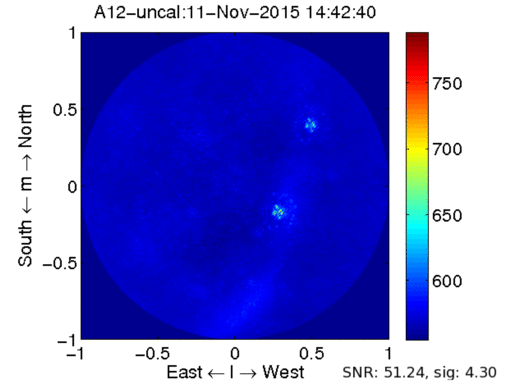Daily Image
07-01-2016AARTFAAC 12-station correlator commissioned
| Submitter: | Peeyush Prasad, for the AARTFAAC team |
| Description: | The AARTFAAC project has achieved a significant milestone with the demonstration of the working of the 12 station correlator. AARTFAAC piggybacks on LOFAR observations by correlating the signals from the 576 individual dual-pol antennas on 12 LOFAR core stations. The goal is to detect transients, by creating an all-sky image every second and examining the image timeseries for transients and variability of the detected sources. The AARTFAAC correlator is a GPU based system which processes an input data rate of ~60Gbps from upto 16 subbands from the 576 antennas of the AARTFAAC-12 array. It estimates the ~166000 instantaneous visibilities per spectral channel, per polarization, per second, in real time. The 6-station AARTFAAC correlator was already functional for half of 2015. The correlator channelizes the subbanded dipole data, applies a bandpass correction and a phase correction to compensate for the slightly different clock cable lengths to each station, and correlates the signals. It consists of a machine with no less than 10 GPUs, capable of handling 16 subbands. A second machine that will correlate 16 more subbands has just arrived and will be installed soon. Together, they will operate 34 TFLOPS continuously, more than three times the performance of the LOFAR correlator. Much effort was put in optimizing the GPU code and in handling the high data rates from the network interfaces: receiving 60 Gb/s of input data, buffering, and offloading the data to the GPUs in real time is not easily done by a single machine. The 12-station AARTFAAC adds 6 more stations from the inner ring of the LOFAR core, significantly increasing the sensitivity (>2x) and resolution (~3x) of AARTFAAC. An example of things to come can be already seen in the above single subband, 1second integrated uncalibrated images of the full sky, using the output of the 12-station correlator. The image labeled A12 has been generated using uncalibrated visibilities from all 12 AARTFAAC stations, while the one labeled A6 is created using visibilities from the 6 superterp stations. The two sources of bright emission are the familiar Cassieopia-A and Cygnus-A, lying within the band of Galactic emission. The higher brightness of the Galactic center (due South) in the A6 image shows the relatively larger number of short baselines in that array. The signal-to-noise and noise variances are indicative since the data are not calibrated. Exciting times are ahead! |
| Copyright: | www.aartfaac.org |
| Tweet |  |
